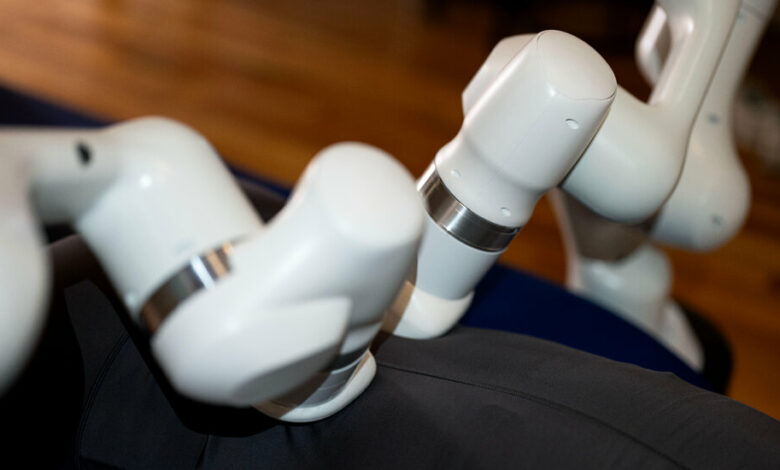30 minutes with the ‘most advanced’ massage robot in the world

In many ways, the room looked familiar. As in previous massages I had had, the lights were dim, the air smelled faintly of aromatherapy, and an inviting bed sat in the center of the room.
But one thing was different: attached to the bed were two large, white robotic arms that worked on my body for half an hour.
The massive machine was developed by Aescape, a New York-based startup that claims to have created “the world’s most advanced massage.” The device contains infrared sensors that scan the body to create a detailed map of muscle structure. It then uses machine learning to analyze the information and create a personalized massage plan. The robot is currently available at a hotel and massage studio in New York City, and Aescape says it will be available at 10 Equinox locations this month.
The company is betting that the parts of a traditional massage that some people find uncomfortable – the oils, the nudity, the small talk – can be solved with the help of artificial intelligence and robotics.
I was at Aescape’s Manhattan office to test the theory.
I put on an outfit the company provided (leggings and a tight long-sleeved shirt). Once on the bed, I laid face down, with my head in a donut pillow and my arms resting comfortably on a cushion. On the other side of the pillow was a touch screen. I tapped a button to get started.
The session started with the body scan, which created a fairly accurate digital representation of my body silhouette on the screen, allowing me to follow the robot as it massaged. I could also adjust the pressure and music, and there were buttons to pause or request an “emergency stop.”
The company isn’t trying to replace massage therapists, said Eric Litman, Aescape’s founder and CEO. The idea is for the robots to provide a consistent experience for returning customers wherever they are, “similar to what Uber did for taxis,” he said.
Unlike a human massage therapist, the device can also work on both sides of a person simultaneously.
I like getting massages to improve my sleep. But they can be expensive, and a quick, non-nude alternative appealed to me. I also wondered if I would feel more relaxed with a machine than with a stranger. For example: I like pressure, but when a massage therapist asks me how the pressure is, I almost always say it’s great—not because it is, but because I don’t like talking to strangers while naked and I’m too embarrassed to ask them to work harder.
The humming machine first warmed up my body with long, gentle strokes. When the “end effectors,” or robot hands, applied pressure to my back, they felt remarkably like human elbows removing knots. (Aescape says the robot can mimic the feel of a knuckle, palm, forearm, elbow and more.) I increased the pressure, but didn’t need to go all the way.
Michael Bottrill, the president and chief executive officer of the Swedish Institute College of Health Sciences in Manhattan, said robots should be integrated into traditional massage practices to help massage therapists avoid burnout and injuries.
“The real, deep work that is super focused, where the patient and the therapist discuss exactly what the goals should be, that is where our therapist would step in,” he said, adding that the institute is currently working on integrating AI into its massage therapy curriculum.
About 11 minutes into my massage, the robot took a break. The screen prompted me to take a deep breath while the machine recalibrated and adjusted its “stroke placement” for a few moments. I couldn’t see exactly what it was doing; I was lying facedown on the table and was afraid that if I turned to see it, I might get smacked in the face by a machine.
David Azaria, a lead engineer at Aescape, said that ideally, there would be no breaks during the sessions and that the company was still refining the product. Like many tech products, the robots receive software updates every few weeks, Litman said, adding that the product will improve over time.
The team is working on teaching the robot new massage techniques so that it can massage different parts of the body with different movements. But so far, the range is limited; the machine can currently only massage the back and glutes.
During my session, the robot paused not once, but twice. The second time, it froze completely. An engineer had to come into the room and reboot the machine from scratch.
Like much of the technology in the AI and robotics space, Aescape’s machine is still working out its problems. But ultimately, I slept well.
Maxwell Strachan contributed reporting.




